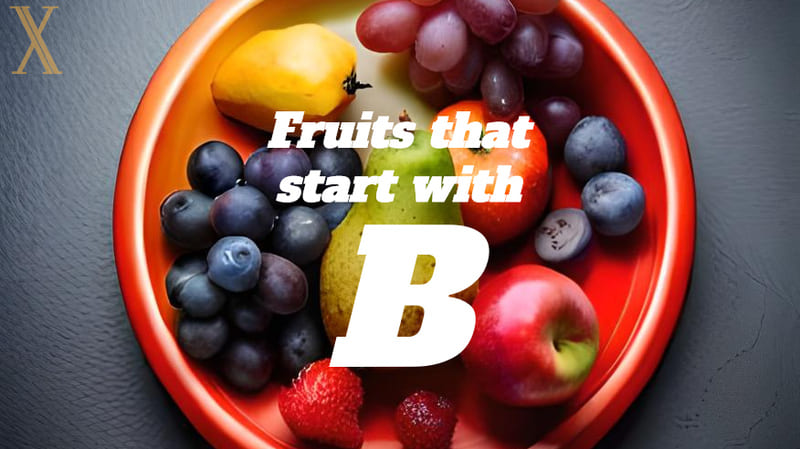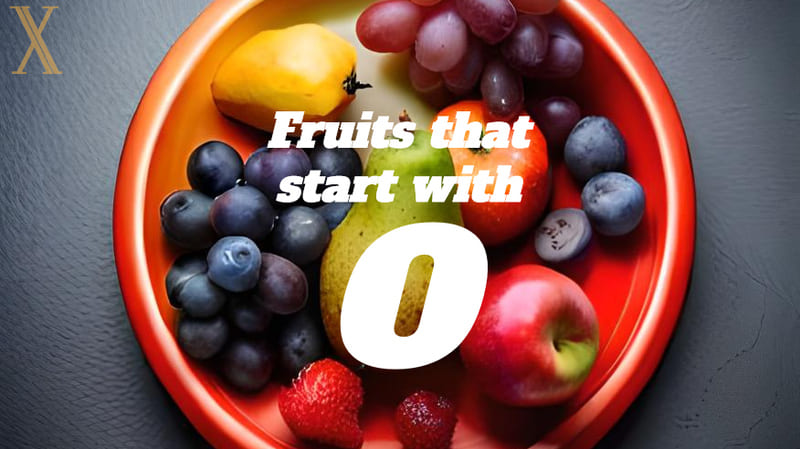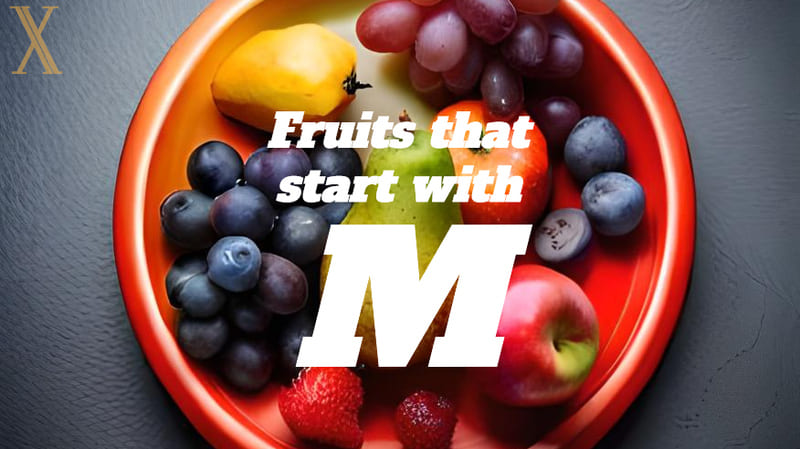
Are you tired of the same old fruits and looking to expand your horizons? Look no further than fruits that start with the letter B! From the tropical sweetness of babaco to the sour tanginess of bacaba; the B fruits offer diverse flavors and health benefits. In this guide, we’ll explore some of the most delicious and nutritious fruits that start with B, including their origins, taste, and uses.
Babaco
Babaco is a type of fruit native to the Andean region of South America but is now also grown in other parts of the world, such as New Zealand and Hawaii. It is pear-shaped, with yellow-green skin often covered in small, raised bumps. The fruit is typically eaten raw and has a sweet, tropical flavor that is often compared to a combination of papaya and pineapple. It is also rich in vitamins and minerals such as vitamin C, potassium, and calcium.
Bacaba
Bacaba is a small, round fruit native to the Amazon rainforest in South America. It has a thin, hard outer shell must be cracked open to reveal the soft, creamy flesh inside. The fruit has a slightly sour taste, often described as a mix between a grape and a lemon, and is often used to make juice or other beverages. Bacaba is also rich in antioxidants and is believed to have several health benefits, such as improving immune function and reducing inflammation.
Bael fruit
Bael fruit, also known as the wood apple, is native to India and Southeast Asia. It has a rugged, woody exterior that must be cracked open to reveal the soft, fibrous pulp inside. The fruit is sweet and slightly tangy and is often used to make juice or other beverages. Bael fruit is also believed to have many health benefits, such as improving digestion and reducing the risk of certain diseases.
Balsam apple
The Balsam apple, also known as bitter melon, is a fruit commonly grown in tropical regions of Asia, Africa, and the Caribbean. It has a distinctive appearance, with a green, warty exterior and a long, oblong shape. The fruit has a bitter taste, an acquired taste for some people. Balsam apple is often used in traditional medicine to treat various ailments, including diabetes, high blood pressure, and skin infections.
Banana
Bananas are a type of fruit native to the tropical regions of Southeast Asia but are now grown in many parts of the world. They have soft, sweet flesh that is typically eaten raw and are often used in baked goods and smoothies. Bananas are rich in potassium, vitamin C, and other nutrients. They are believed to have several health benefits, such as improving digestion and reducing the risk of certain diseases. They are also a popular source of energy for athletes and active individuals.
Barbadine
Barbadine, also known as giant granadilla, is a type of fruit that is native to South America but is now grown in many parts of the world. It has a hard, green outer shell and a soft, white interior filled with seeds. The fruit has a sweet, tart flavor and is often eaten fresh or used in juices and desserts. Barbadine is rich in vitamin C, fiber, and other nutrients and is believed to have many health benefits, such as promoting digestion and boosting the immune system.
Barbados cherry
Barbados cherry, also known as acerola cherry, is a fruit native to the Caribbean and Central and South America. It has a bright red color and a sweet, tart flavor and is rich in vitamin C and other nutrients. Barbados cherry is often used in juices and smoothies and is believed to have many health benefits, such as improving immune function and reducing the risk of certain diseases.
Barberry
Barberry is a type of fruit native to Europe but is now grown in many parts of the world. It has a distinctive appearance, with small, red berries that grow in clusters on shrubs. The fruit has a tart, slightly bitter flavor, and you can use it in jams, jellies, and other preserves. Barberry is also used in traditional medicine to treat various ailments, such as digestive problems and urinary tract infections.
Bayberry
Bayberry is a type of fruit native to North America, and you can usually find it in coastal areas of the eastern United States. The fruit is small and dark purple, and you can prepare candles, soaps, and other fragrant products with it due to its aromatic qualities. The bayberry plant is also used in traditional medicine, and there is a belief that it has many health benefits, such as promoting digestion and reducing inflammation.
Beach plum
Beach plum is a type of fruit that is native to the northeastern United States and is commonly found in coastal areas. The fruit is small in size, has a deep purple color, and has a sweet, tart flavor. Beach plums are often used in jams, jellies, other preserves, and traditional medicine to treat various ailments. The beach plum plant is also used as a decorative plant due to its attractive appearance and hardiness.
Bearberry
Bearberry is a fruit native to North America, Europe, and Asia. It is small and bright red, and people use it in traditional medicine due to its high levels of antioxidants. In addition, Bearberry is believed to have some health benefits, such as promoting urinary tract health and reducing inflammation.
Bell fruit
Bell fruit, also known as the “golden apple,” is a fruit native to Southeast Asia. It has a round shape and a bright yellow color and has a sweet, tangy flavor. Some people use the bell fruit in desserts and jams; people claim it has several health benefits, such as improving digestion and reducing inflammation.
Bergamot orange
Bergamot orange is a type of citrus fruit that is native to Italy. It has a small size and a yellow color and has a distinctive flavor that is both bitter and sweet. You can use bergamot orange to produce essential oils, perfumes, tea, and other fragrant products. The fruit is also believed to have many health benefits, such as reducing anxiety and promoting digestive health.
Betel nut
Betel nut, or areca nut, is a fruit commonly used in Asia as a mild stimulant. It has a small size and a brown color and is often chewed with other ingredients such as betel leaf and tobacco. Betel nut is known for its stimulating effects on the central nervous system. It is also believed to have a number of health benefits such as improving digestion and reducing inflammation.
Bilberry
Bilberry is a small, dark blue fruit similar to a blueberry. It is native to Europe and is often used in traditional medicine to improve vision and circulation. Bilberry is also known for its high levels of antioxidants, which can help to reduce inflammation and protect against oxidative damage.
Bitter gourd
Bitter gourd, also known as bitter melon, is a fruit commonly used in Asian and African cuisines. It has a unique, bitter flavor and is often used in traditional medicine to lower blood sugar levels and improve digestion. Bitter gourd is also a rich source of vitamins and minerals, making it a nutritious addition to any diet.
Black apple
The black apple, also known as the black diamond apple, is a rare apple native to the mountains of Tibet. It is known for its unique, deep purple-black color and crisp texture. The black apple is rich in antioxidants and has a sweet, slightly tart flavor that makes it a popular choice for eating fresh or using in desserts.
Black cherry
Black cherry, also known as sweet cherry, is widely cultivated for its sweet, juicy flesh. It is a rich source of vitamin C, potassium, and antioxidants, which can help to reduce inflammation and protect against oxidative damage. Black cherry is often used in desserts but can also be eaten fresh or in savory dishes.
Black currant
The black currant is a small, dark purple fruit that grows on shrubs known for its tart and tangy flavor. It is a rich source of vitamin C and antioxidants, which can help to strengthen the immune system and protect against disease. Black currants are commonly used in jams, jellies, and syrups to flavor baked goods and beverages.
Black elderberry
Black elderberry, also known as Sambucus nigra, is a fruit commonly used for medicinal properties. It is a rich source of antioxidants, and studies have shown it to have antiviral and anti-inflammatory effects. Black elderberry is frequently used to treat colds and flu and as a natural remedy for allergies, sinusitis, and other respiratory conditions.
Blackberry
Blackberry is a type of fruit that grows on thorny bushes and is known for its sweet and tangy flavor. It is a rich source of fiber, vitamins, and antioxidants, which can help to support digestive health, boost the immune system, and reduce the risk of chronic disease. You probably know that blackberries are a good source for jams, jellies, desserts, and savory dishes such as salads and sauces.
Blackthorn
Blackthorn (Prunus spinosa) is a fruit-bearing shrub or small tree native to Europe, Western Asia, and North Africa. The fruit of the blackthorn is known as sloe and is a small blue-black drupe with a sour and astringent taste. It is often used to make sloe gin, jams, and jellies. The blackthorn has a long history of medicinal use, and its leaves, bark, and fruit have been used to treat various ailments.
Blimbing
Blimbing (Averrhoa bilimbi) is a tropical fruit tree native to Indonesia but is also found in other parts of Southeast Asia, India, and Sri Lanka. The fruit of the blimbing is a green or yellow-green, elongated fruit with a sour taste, similar to that of a green apple or a tart grape. It is often used in Southeast Asian cuisine to add a sour flavor to dishes and traditional medicine.
Blood Orange
Blood orange is a citrus fruit with a distinct reddish hue to its flesh, which is why it is named as such. The fruit originated in Sicily, Italy, and is a natural mutation of the sweet orange. Blood oranges are in season from December to April and are known for their sweet, juicy taste with a hint of raspberry. They are a good source of vitamin C and are often used in juice blends, cocktails, and salads.
Blue Honeysuckle
Blue honeysuckle, also known as honeyberry, is a small, blue-purple fruit that grows on a deciduous shrub native to Siberia, Russia, and parts of Japan. It tastes similar to blueberries but has a more complex flavor that is a mix of sweet and tart. Blue honeysuckle is high in antioxidants, vitamin C, and fiber. It is a relatively new fruit to the market and is gaining popularity due to its unique flavor and health benefits.
Blueberry
Blueberries are small, blue-purple berries that grow on a shrub belonging to the heath family. They are native to North America but are now widely cultivated in many regions of the world. Blueberries are high in antioxidants, vitamin C, and fiber. They are sweet and slightly tangy and are commonly used in desserts, jams, and sauces. Blueberries are also popular in smoothies, salads, and yogurt bowls.
Borojo
Borojo is a tropical fruit that grows on a tree native to the rainforests of South America. The fruit is round and small, with a thick brown skin and soft, creamy flesh. Its unique flavor is a mix of chocolate and vanilla, often used in drinks, desserts, and jams. People believe that borojo has several health benefits, such as improving digestion, boosting energy levels, and promoting weight loss.
Bottle Gourd
Bottle gourd is a squash commonly grown in tropical and subtropical regions worldwide. The fruit has a long, cylindrical shape and smooth, light green skin. It is often used in Asian and African cuisine and is known for its mild, slightly sweet taste. Bottle gourd is a good source of vitamins and minerals and is believed to have several health benefits, such as improving digestion and promoting weight loss. You can use it in various dishes, including stews, soups, and curries.
Boysenberry
Boysenberry is a fruit hybrid between raspberry, blackberry, and loganberry. Its name comes from its developer, horticulturist Rudolph Boysen. The fruit has a dark reddish-purple color and is soft and juicy with a sweet-tart taste. It is a good ingredient for making jams, pies, and other desserts.
Boysenberry bushes are large and thorny; the fruit is best-harvested mid-summer. The fruit is rich in vitamin C and other antioxidants, making it a healthy addition to your diet. It is also low in calories and high in fiber, making it an excellent snack for weight loss.
Brazil nut fruit
The Brazil nut fruit is a large, round, woody capsule that contains between 12 and 20 Brazil nuts. The fruit grows on the Brazil nut tree, native to the Amazon rainforest in South America. The fruit is harvested when it falls to the ground, and the nuts are extracted and sold for consumption.
The Brazil nut fruit is a rich source of healthy fats, protein, and micronutrients such as selenium, magnesium, and phosphorus. These nutrients are essential for maintaining healthy bones, muscles, and nerve function. In addition, the Brazil nut fruit is also high in antioxidants, which can help reduce the risk of chronic diseases such as heart disease and cancer.
Brazilian guava
Brazilian guava, also known as yellow guava or guava do cerrado, is a small, yellow fruit native to Brazil. The fruit is about the size of a golf ball and has a sweet, tangy flavor with a hint of tropical fruit. It is commonly eaten raw, used to make juices, or used in desserts.
Brazilian guava is rich in vitamin C, fiber, and antioxidants, making it a healthy addition to your diet. It is also low in calories and has a low glycemic index, so that it won’t cause a rapid spike in blood sugar levels. In addition, the fruit contains compounds that may have anti-inflammatory and anti-cancer properties.
Breadfruit
Breadfruit is a large, starchy fruit native to the South Pacific islands. It is a staple food in many tropical countries and can be cooked in a variety of ways, including boiling, roasting, and frying. The fruit has a mild, slightly sweet flavor and a texture similar to bread.
Breadfruit is a good source of carbohydrates, fiber, and vitamins such as vitamin C, potassium, and folate. These nutrients are essential for maintaining good health and can help prevent various diseases. In addition, the fruit contains antioxidants that may help protect against cellular damage and reduce the risk of chronic diseases such as heart disease and cancer.
Broadleaf bramble
Broadleaf bramble is a type of fruit that grows on a shrub and is native to North America. The fruit is small and dark purple, with a sweet and slightly tart flavor. It is commonly used in making jams, jellies, and pies and is a popular ingredient in traditional Native American cuisine.
Broadleaf bramble is a good source of fiber, vitamin C, and antioxidants, making it a healthy addition to your diet. It is also low in calories and has a low glycemic index; therefore, it won’t cause a rapid spike in blood sugar levels. In addition, the fruit contains compounds that may have anti-inflammatory and anti-cancer properties.
Buddha’s hand
Buddha’s hand, also known as the fingered citron, is a fragrant and peculiar-looking fruit that originates from China. The fruit is named after its finger-like shape, which resembles a hand in a praying position. The fruit has no pulp or juice, and its fragrant rind is used for culinary and medicinal purposes. The aroma of the fruit is similar to a lemon or lime, often used to flavor desserts, candies, and cocktails.
Buffaloberry
Buffaloberry, also known as silver buffaloberry or soapberry, is a small, bright red fruit that grows on a shrub. The fruit is native to North America and known for its tart flavor and high nutrient content. The fruit is a rich source of antioxidants, vitamin C, and carotenoids, making it a popular ingredient in health supplements and herbal remedies.
Burdekin plum
The Burdekin plum, also known as the cocky apple or the wilgy, is a small, red fruit native to Australia. The fruit is highly valued for its sweet and tangy flavor, often compared to cherry or raspberry. The fruit is also rich in antioxidants and vitamin C, often used in traditional Aboriginal medicine to treat various ailments.
Butternut squash
Butternut squash is a type of winter squash commonly used in cooking. It has a bulbous shape with smooth, tan skin and bright orange flesh. The flesh is sweet and nutty, with a texture similar to pumpkin. Butternut squash is rich in vitamins and minerals, including vitamins A, C, and potassium.
-

The Encyclopedia for the Fruits That Start with O
-

Fruitful N: Discovering Exotic Fruits That Start With N
-

The Mighty M’s: A Guide to Fruits That Start with M
-

Fruits that Start with L: From Lablab to Lychee
-

35+ Fruits that Start With K (with a short description)
-

25+ Fruits that Start with J: A comprehensive list
